View in other NatureServe Network Field Guides
NatureServe
Montana
Utah
Wyoming
Idaho
Wisconsin
British Columbia
South Carolina
Yukon
California
New York
Western Skink - Plestiodon skiltonianus
State Rank Reason (see State Rank above)
Species is rare to uncommon within western Montana. Status is uncertain as trend data are unavailable and threats are poorly characterized. Threats likely include habitat loss from urbanization, fire and fire suppression impacting habitat suitability, and predation by domestic cats.
General Description
EGGS:
Eggs are white, leathery, oval, and about 12-15 mm (0.45-0.6 in) in length. Clutch size is typically 2-6 eggs, but up to 10 may be laid (Tanner 1957, Nussbaum et al. 1983, St. John 2002, Stebbins 2003). Eggs are laid in a cavity in the ground under a rock or log and are guarded by the female.
HATCHLINGS:
Young animals are similar in appearance to adults but have a brilliant blue tail that becomes progressively duller with age.
JUVENILES AND ADULTS:
The body is slender and elongated, with a tail that is about as long as the remainder of the body. The body is covered in smooth, rounded scales, and has an overall shiny appearance. Dorsal coloration consists of brown, black, and golden-yellow- or cream-colored longitudinal stripes that extend from the nose to the anterior portion of the tail. The belly is light gray to cream-colored, with faint greenish-blue mottling. Males develop reddish-orange coloration on the chin and sides of head during the breeding season. Adults are about 5.0-8.0 cm (2-3.1 in) snout-vent length (SVL) and up to 19.0 cm (7.5 in) total length (TL) (Tanner 1957, St. John 2002, Stebbins 2003, Werner et al. 2004). Some individuals may have a stumpy tail, resulting from tail autotomy in response to predator attack (Vitt et al. 1977, St. John 2002, Paul Hendricks personal communication).
Diagnostic Characteristics
The Western Skink (
Plestiodon skiltonianus) is the only lizard in Montana with a body that appears smooth and shiny with juveniles and young adults having a blue tail. Western Skink lack a skin fold on the side of the body compared to the Northern Alligator Lizard (
Elgaria coerulea) with which it is sympatric. Unlike the Greater Short-horned Lizard (
Phrynosoma hernandesi), Common Sagebrush Lizard (
Sceloporus graciosus), and Western Fence Lizard (
S. occidentalis), this species does not have keeled scales. Other Montana lizards do not display distinct dorsal stripes, which are present on the Western Skink (St. John 2002, Werner et al. 2004). Only the Northern Alligator Lizard occurs in the range of the Western Skink in Montana.
Species Range
Montana Range
Range Descriptions
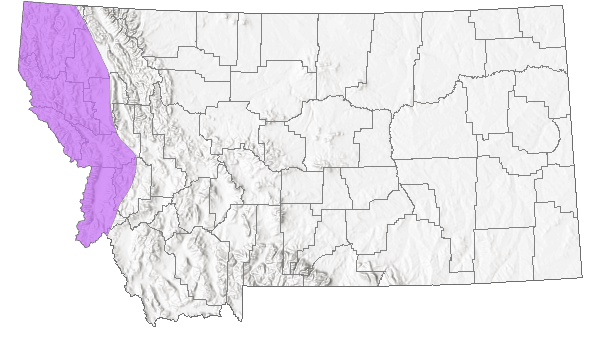
 Native
Native
Western Hemisphere Range

Range Comments
The Western Skink is the most widespread, and possibly the most abundant, skink in western North America, being found west of the Continental Divide from southern British Columbia in the north, south through eastern Washington, Idaho, western Montana, Oregon, northern and coastal California, Nevada, western Utah, northwestern Arizona, and southwestern California, to northern Baja California (Rodgers and Fitch 1947, Tanner 1988a, Richmond and Reeder 2002), at elevations to about 2,530 m (8,300 ft). Four subspecies are sometimes recognized (Tanner 1988a, Stebbins 2003): Eumeces skiltonianus skiltonianus in the northern Rocky Mountains and Pacific Coast, E. s. utahensis in the core of the Great Basin, E. s. interparietalis of extreme southwest California and northern Baja California, and E. s. lagunensis isolated in the southern half of Baja California. Recent analyses of genetic and morphological traits from throughout the range of the Western Skink (Richmond and Reeder 2002) support the validity of the earlier classification of Tanner (1957), with three subspecies of Western Skink and the isolated subspecies E. s. lagunensis of southern Baja California considered a full species, the San Lucan Skink (E. lagunensis). The form of Western Skink so far documented in Montana is Skilton’s skink (E. s. skiltonianus), although the Great Basin Skink (E. s. utahensis) is present in parts of Idaho abutting Beaverhead County, where suitable habitat occurs on both sides of the state boundary (Maxell et al. 2003). In Montana, there are about 50 records from five counties west of the Continental Divide; reports from Flathead County need verification (Maxell et al. 2003, Werner et al. 2004). Given the species known distribution in Idaho, it is possible that the species is present in portions of Beaverhead County.
Maximum Elevation: 1,707 m (5,600 ft) in Missoula County (Ortega and Pearson 2001, Maxell et al. 2003).
Observations in Montana Natural Heritage Program Database
Number of Observations: 125
(Click on the following maps and charts to see full sized version)
Map Help and Descriptions
Relative Density
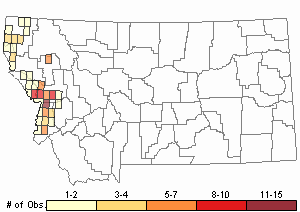
Recency
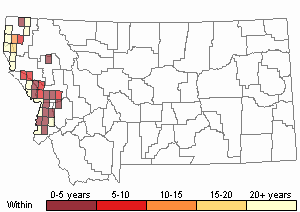

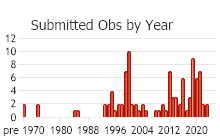
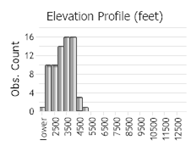 (Observations spanning multiple months or years are excluded from time charts)
(Observations spanning multiple months or years are excluded from time charts)
Migration
No information is currently available for Montana. The species is non-migratory, but there are no data on home range sizes and movements.
Habitat
The Western Skink occupies grasslands, chaparral, open Juniper-Sage shrublands, Piñon-Juniper
woodlands, Pine-Oak forests, and mixed conifer forest. Grassy openings and rocky areas near
streams in the above habitats are frequented, where Western Skinks often found under dried leaves, flat rocks, and other ground cover (Nussbaum et al. 1983, St. John 2002), but dry hillsides with some shade are also occupied. Western Skink can also be found in downed decaying wood. This lizard tends to be less abundant in dense shrub cover (Tanner 1957), although it may forage in such sites. They do not appear to inhabit areas with deep soil or sand, although both sexes dig burrows that may be up to 50 cm (19.7 in) long.
Habitat use in Montana has been little studied. In Sanders County, Western Skinks were found in open stands of Ponderosa Pine (
Pinus ponderosa) in or near talus, and at meadow edges (Boundy 2001). In Mineral, Missoula, and Ravalli counties, Western Skinks were found in
Agropyron spicatum-Poa sandbergii grasslands on southwest aspects. These sites were gently rolling (< 20% slope) with imbedded rocky areas, to rocky and steep terrain (average slope of 30%). Slopes contained scattered Ponderosa Pine and Douglas-fir (
Pseudotsuga menziesii), imbedded in a matrix of montane coniferous forest (Ortega and Pearson 2001). Many of these occupied sites supported moderate to high densities of exotic Spotted Knapweed (
Centaurea stoebe).
Ecological Systems Associated with this Species
- Details on Creation and Suggested Uses and Limitations
How Associations Were Made
We associated the use and habitat quality (common or occasional) of each of the 82 ecological systems mapped in Montana for
vertebrate animal species that regularly breed, overwinter, or migrate through the state by:
- Using personal observations and reviewing literature that summarize the breeding, overwintering, or migratory habitat requirements of each species (Dobkin 1992, Hart et al. 1998, Hutto and Young 1999, Maxell 2000, Foresman 2012, Adams 2003, and Werner et al. 2004);
- Evaluating structural characteristics and distribution of each ecological system relative to the species' range and habitat requirements;
- Examining the observation records for each species in the state-wide point observation database associated with each ecological system;
- Calculating the percentage of observations associated with each ecological system relative to the percent of Montana covered by each ecological system to get a measure of "observations versus availability of habitat".
Species that breed in Montana were only evaluated for breeding habitat use, species that only overwinter in Montana were only evaluated for overwintering habitat use, and species that only migrate through Montana were only evaluated for migratory habitat use.
In general, species were listed as associated with an ecological system if structural characteristics of used habitat documented in the literature were present in the ecological system or large numbers of point observations were associated with the ecological system.
However, species were not listed as associated with an ecological system if there was no support in the literature for use of structural characteristics in an ecological system,
even if point observations were associated with that system.
Common versus occasional association with an ecological system was assigned based on the degree to which the structural characteristics of an ecological system matched the preferred structural habitat characteristics for each species as represented in scientific literature.
The percentage of observations associated with each ecological system relative to the percent of Montana covered by each ecological system was also used to guide assignment of common versus occasional association.
If you have any questions or comments on species associations with ecological systems, please contact the Montana Natural Heritage Program's Senior Zoologist.
Suggested Uses and Limitations
Species associations with ecological systems should be used to generate potential lists of species that may occupy broader landscapes for the purposes of landscape-level planning.
These potential lists of species should not be used in place of documented occurrences of species (this information can be requested at:
mtnhp.mt.gov/requests) or systematic surveys for species and evaluations of habitat at a local site level by trained biologists.
Users of this information should be aware that the land cover data used to generate species associations is based on imagery from the late 1990s and early 2000s and was only intended to be used at broader landscape scales.
Land cover mapping accuracy is particularly problematic when the systems occur as small patches or where the land cover types have been altered over the past decade.
Thus, particular caution should be used when using the associations in assessments of smaller areas (e.g., evaluations of public land survey sections).
Finally, although a species may be associated with a particular ecological system within its known geographic range, portions of that ecological system may occur outside of the species' known geographic range.
Literature Cited
- Adams, R.A. 2003. Bats of the Rocky Mountain West; natural history, ecology, and conservation. Boulder, CO: University Press of Colorado. 289 p.
- Dobkin, D. S. 1992. Neotropical migrant land birds in the Northern Rockies and Great Plains. USDA Forest Service, Northern Region. Publication No. R1-93-34. Missoula, MT.
- Foresman, K.R. 2012. Mammals of Montana. Second edition. Mountain Press Publishing, Missoula, Montana. 429 pp.
- Hart, M.M., W.A. Williams, P.C. Thornton, K.P. McLaughlin, C.M. Tobalske, B.A. Maxell, D.P. Hendricks, C.R. Peterson, and R.L. Redmond. 1998. Montana atlas of terrestrial vertebrates. Montana Cooperative Wildlife Research Unit, University of Montana, Missoula, MT. 1302 p.
- Hutto, R.L. and J.S. Young. 1999. Habitat relationships of landbirds in the Northern Region, USDA Forest Service, Rocky Mountain Research Station RMRS-GTR-32. 72 p.
- Maxell, B.A. 2000. Management of Montana's amphibians: a review of factors that may present a risk to population viability and accounts on the identification, distribution, taxonomy, habitat use, natural history, and the status and conservation of individual species. Report to U.S. Forest Service Region 1. Missoula, MT: Wildlife Biology Program, University of Montana. 161 p.
- Werner, J.K., B.A. Maxell, P. Hendricks, and D. Flath. 2004. Amphibians and reptiles of Montana. Missoula, MT: Mountain Press Publishing Company. 262 p.
- Commonly Associated with these Ecological Systems
Forest and Woodland Systems
Grassland Systems
Shrubland, Steppe and Savanna Systems
Sparse and Barren Systems
Wetland and Riparian Systems
- Occasionally Associated with these Ecological Systems
Forest and Woodland Systems
Grassland Systems
Recently Disturbed or Modified
Food Habits
Adults and juveniles actively forage, albeit haltingly and in a “cat-like” stalk (Tanner 1957, Nussbaum et al. 1983, St. John 2002). They hunt mainly by sight and remain near cover. Arthropods form the diet, with several orders of insects (including beetles, crickets, grasshoppers, and moths) as well as spiders, centipedes, and sow bugs (terrestrial isopods) are taken (Tanner 1957). Ants are rarely consumed. Sometimes individuals are cannibalistic, with adults eating small juveniles (St. John 2002).
Ecology
This species of lizard is found up to 2,150 m (7,054 ft) elevation in the Pacific Northwest. They are diurnal and may construct burrows up to 50 cm (19.7 in) long (Nussbaum 1983). Home range size has not been reported, but females probably restrict movement to small areas once eggs are laid, as they often remain with their clutches until eggs hatch (Tanner 1957). Western Skinks appear to be somewhat gregarious, further suggesting that home ranges may be relatively small, although this species does not seem to be territorial (Tanner 1957).
Reproductive Characteristics
Mating in parts of Utah occurs through May and into June, a few weeks after emergence from winter dormancy (Tanner 1957). Eggs are laid in Utah during the first two weeks of July. Timing of egg laying in coastal California is like Utah (Rodgers and Memmler 1943), although some clutches are laid by mid- and late June (Tanner 1957). A single clutch is produced (Fitch 1970). The number of eggs in eight Utah clutches was 2-5, but as many as 10 eggs have been reported (St. John 2002). Eggs hatch in at least 30 days (Rodgers and Memmler 1943), in August and September, with an estimated full incubation period of 40-60 days (Werner et al. 2004). No information is available from Montana on any aspect of the reproductive biology of this species; adults and juveniles have been reported from early April to October (Werner and Reichel 1994, Hendricks and Reichel 1996a, Boundy 2001, Ortega and Pearson 2001). The Western Skink is the only native reptile in the Pacific Northwest that will stay and guard their eggs until they hatch. In Utah, males reach sexual maturity when two years old (Tanner 1957), and apparently so do females. There appears to be no size dimorphism between the sexes, although males appear to have longer legs (Rodgers and Fitch 1947). No information is available on survival rate and longevity of Western Skinks but reproducing once per season (Fitch 1970, St. John 2002, Maxell et al. 2009) suggests that they may be relatively long-lived (Vitt et al. 1977).
Management
The following was taken from the Status and Conservation section for the Western Skink account in
Maxell et al. 2009.
At the time the comprehensive summaries of amphibians and reptiles in Montana (Maxell et al. 2003, Werner et al. 2004) were published, there were 51 total records for Western Skink from five counties west of the Continental Divide, with records concentrated near the Idaho state line. With so few records, the current status in Montana is largely uncertain. The Western Skink has not been documented in or near Glacier National Park (Brunson and Demaree 1951, Marnell 1997), and the few reports from the Flathead Valley require verification (Werner et al. 1998a). There is also a noticeable absence of records north of the Kootenai River in Lincoln County, and east of Missoula and Ravalli counties, despite seemingly suitable habitat in both regions. At the local scale, limited data from elsewhere suggest this species is relatively sedentary and gregarious (Tanner 1957). Thus, populations appear vulnerable to habitat fragmentation. Densities of this species have not been determined, but trapping data indicate they may sometimes be locally abundant (Ortega and Pearson 2001). Risk factors relevant to the viability of populations of this species are likely to include habitat loss/fragmentation, fire, road and trail development, quarrying, and use of pesticides and herbicides. However, perhaps the greatest risk to maintaining viable populations of Western Skink in Montana is the lack of baseline data on its distribution, status, habitat use, and basic biology (Maxell and Hokit 1999), which are needed to monitor trends and recognize dramatic declines when and where they occur. Few studies address or identify risk factors. In Utah, Western Skinks appeared to decline at sites following dramatic increase in sagebrush (
Artemisia sp.) cover (Tanner 1957). Some open terrain is needed to allow sunlight to warm shelter and nesting cover of flattened rocks and wood. However, some vegetative cover appears to be required for shelter while foraging. Invasion of exotic weeds into occupied habitat has and continues to occur in western Montana (Ortega and Pearson 2001), but it is unclear how associated habitat changes may affect skink populations. Use of chemical agents to control weed and insect pest infestations could depress populations of Western Skinks, which feed on ground-dwelling arthropods.
Stewardship Responsibility
References
- Literature Cited AboveLegend:
 View Online Publication
View Online Publication Boundy, J. 2001. Herpetofaunal surveys in the Clark Fork Valley region, Montana. Herpetological Natural History 8: 15-26.
Boundy, J. 2001. Herpetofaunal surveys in the Clark Fork Valley region, Montana. Herpetological Natural History 8: 15-26. Brunson, R.B. and H.A. Demaree, Jr. 1951. The herpetology of the Mission Mountains, Montana. Copeia (4):306-308.
Brunson, R.B. and H.A. Demaree, Jr. 1951. The herpetology of the Mission Mountains, Montana. Copeia (4):306-308. Fitch, H.S. 1970. Reproductive cycles in lizards and snakes. University of Kansas. Museum Natural History Miscellaneous Publication 52:1-247.
Fitch, H.S. 1970. Reproductive cycles in lizards and snakes. University of Kansas. Museum Natural History Miscellaneous Publication 52:1-247. Hendricks, P. and J.D. Reichel. 1996a. Amphibian and reptile survey of the Bitterroot National Forest: 1995. Montana Natural Heritage Program. Helena, MT. 95 p.
Hendricks, P. and J.D. Reichel. 1996a. Amphibian and reptile survey of the Bitterroot National Forest: 1995. Montana Natural Heritage Program. Helena, MT. 95 p. Marnell, L. E. 1997. Herpetofauna of Glacier National Park. Northwestern Naturalist 78:17-33.
Marnell, L. E. 1997. Herpetofauna of Glacier National Park. Northwestern Naturalist 78:17-33. Maxell, B.A. and D.G. Hokit. 1999. Amphibians and reptiles. Pages 2.1– 2.30 In G. Joslin and H. Youmans, committee chairs. Effects of recreation on Rocky Mountain wildlife: a compendium of the current state of understanding in Montana. Committee on Effects of Recreation on Wildlife, Montana Chapter of the Wildlife Society.
Maxell, B.A. and D.G. Hokit. 1999. Amphibians and reptiles. Pages 2.1– 2.30 In G. Joslin and H. Youmans, committee chairs. Effects of recreation on Rocky Mountain wildlife: a compendium of the current state of understanding in Montana. Committee on Effects of Recreation on Wildlife, Montana Chapter of the Wildlife Society. Maxell, B.A., J.K. Werner, P. Hendricks, and D.L. Flath. 2003. Herpetology in Montana: a history, status summary, checklists, dichotomous keys, accounts for native, potentially native, and exotic species, and indexed bibliography. Society for Northwestern Vertebrate Biology, Northwest Fauna Number 5. Olympia, WA. 135 p.
Maxell, B.A., J.K. Werner, P. Hendricks, and D.L. Flath. 2003. Herpetology in Montana: a history, status summary, checklists, dichotomous keys, accounts for native, potentially native, and exotic species, and indexed bibliography. Society for Northwestern Vertebrate Biology, Northwest Fauna Number 5. Olympia, WA. 135 p. Maxell, B.A., P. Hendricks, M.T. Gates, and S. Lenard. 2009. Montana amphibian and reptile status assessment, literature review, and conservation plan, June 2009. Montana Natural Heritage Program. Helena, MT. 643 p.
Maxell, B.A., P. Hendricks, M.T. Gates, and S. Lenard. 2009. Montana amphibian and reptile status assessment, literature review, and conservation plan, June 2009. Montana Natural Heritage Program. Helena, MT. 643 p. Nussbaum, R.A., E.D. Brodie, Jr. and R.M. Storm. 1983. Amphibians and reptiles of the Pacific Northwest. University of Idaho Press. Moscow, ID. 332 pp.
Nussbaum, R.A., E.D. Brodie, Jr. and R.M. Storm. 1983. Amphibians and reptiles of the Pacific Northwest. University of Idaho Press. Moscow, ID. 332 pp. Ortega, Y.K. and D.E. Pearson. 2001. Occurences of the western skink (Eumeces skiltonianus) in grasslands of western Montana. Northwestern Naturalist 82(3):125-126.
Ortega, Y.K. and D.E. Pearson. 2001. Occurences of the western skink (Eumeces skiltonianus) in grasslands of western Montana. Northwestern Naturalist 82(3):125-126. Richmond, J.Q. and T.W. Reeder. 2002. Evidence for parallel ecological speciation in scincid lizards of the Eumeces skiltonianus species group (Squamata: Scincidae). Evolution 56(7): 1498-1513.
Richmond, J.Q. and T.W. Reeder. 2002. Evidence for parallel ecological speciation in scincid lizards of the Eumeces skiltonianus species group (Squamata: Scincidae). Evolution 56(7): 1498-1513. Rodgers, T.L. and H.S. Fitch. 1947. Variation in the skinks (Reptilia: Lacertilia) of the skiltonianus group. University of California Publications in Zoology 48(4): 169-220.
Rodgers, T.L. and H.S. Fitch. 1947. Variation in the skinks (Reptilia: Lacertilia) of the skiltonianus group. University of California Publications in Zoology 48(4): 169-220. Rodgers, T.L. and V.H. Memmler. 1943. Growth in the western blue-tailed skink. Transactions of the San Diego Society of Natural History 10:63-67.
Rodgers, T.L. and V.H. Memmler. 1943. Growth in the western blue-tailed skink. Transactions of the San Diego Society of Natural History 10:63-67. St. John, A.D. 2002. Reptiles of the northwest: California to Alaska, Rockies to the coast. Lone Pine Publishing, Renton, WA. 272 p.
St. John, A.D. 2002. Reptiles of the northwest: California to Alaska, Rockies to the coast. Lone Pine Publishing, Renton, WA. 272 p. Stebbins, R. C. 2003. A field guide to western reptiles and amphibians. 3rd Edition. Houghton Mifflin Company, Boston and New York. 533 p.
Stebbins, R. C. 2003. A field guide to western reptiles and amphibians. 3rd Edition. Houghton Mifflin Company, Boston and New York. 533 p. Tanner, W.W. 1957. A taxonomic and ecological study of the western skink (Eumeces skiltonianus). Great Basin Naturalist 17(3-4): 59-94.
Tanner, W.W. 1957. A taxonomic and ecological study of the western skink (Eumeces skiltonianus). Great Basin Naturalist 17(3-4): 59-94. Tanner, W.W. 1988a. Eumeces skiltonianus (Baird and Girard). Western skink. Catalogue of American Amphibians and Reptiles No. 447: 1-4.
Tanner, W.W. 1988a. Eumeces skiltonianus (Baird and Girard). Western skink. Catalogue of American Amphibians and Reptiles No. 447: 1-4. Vitt, L.J., J.D. Congdon, and N.A. Dickson. 1977. Adaptive strategies and energetics of tail autotomy in lizards. Ecology 58(2): 326-337.
Vitt, L.J., J.D. Congdon, and N.A. Dickson. 1977. Adaptive strategies and energetics of tail autotomy in lizards. Ecology 58(2): 326-337. Werner, J.K. and J.D. Reichel. 1994. Amphibian and reptile survey of the Kootenai National Forest: 1994. Montana Natural Heritage Program. Helena, MT. 104 p.
Werner, J.K. and J.D. Reichel. 1994. Amphibian and reptile survey of the Kootenai National Forest: 1994. Montana Natural Heritage Program. Helena, MT. 104 p. Werner, J.K., B.A. Maxell, P. Hendricks and D.L. Flath. 2004. Amphibians and Reptiles of Montana. Mountain Press Publishing Company: Missoula, MT. 262 pp.
Werner, J.K., B.A. Maxell, P. Hendricks and D.L. Flath. 2004. Amphibians and Reptiles of Montana. Mountain Press Publishing Company: Missoula, MT. 262 pp. Werner, J.K., T. Plummer, and J. Weaslehead. 1998a. Amphibians and reptiles of the Flathead Indian Reservation. Intermountain Journal of Sciences 4(1-2): 33-49.
Werner, J.K., T. Plummer, and J. Weaslehead. 1998a. Amphibians and reptiles of the Flathead Indian Reservation. Intermountain Journal of Sciences 4(1-2): 33-49.
- Additional ReferencesLegend:
 View Online Publication
View Online Publication
Do you know of a citation we're missing? Black, J.H. and R. Timken. 1976. Endangered and threatened amphibians and reptiles in Montana. p 36–37. In R.E. Ashton, Jr. (chair). Endangered and threatened amphibians and reptiles in the United States. Society for the Study of Amphibians and Reptiles Herpetological Circular 5: 1-65.
Black, J.H. and R. Timken. 1976. Endangered and threatened amphibians and reptiles in Montana. p 36–37. In R.E. Ashton, Jr. (chair). Endangered and threatened amphibians and reptiles in the United States. Society for the Study of Amphibians and Reptiles Herpetological Circular 5: 1-65. Brunson, R.B. 1955. Check list of the amphibians and reptiles of Montana. Proceedings of the Montana Academy of Sciences 15: 27-29.
Brunson, R.B. 1955. Check list of the amphibians and reptiles of Montana. Proceedings of the Montana Academy of Sciences 15: 27-29. Carlson, J. (Coordinator, Montana Animal Species of Concern Committee). 2003. Montana Animal Species of Concern January 2003. Helena, MT: Montana Natural Heritage Program and Montana Fish, Wildlife, and Parks. In Press. 12p.
Carlson, J. (Coordinator, Montana Animal Species of Concern Committee). 2003. Montana Animal Species of Concern January 2003. Helena, MT: Montana Natural Heritage Program and Montana Fish, Wildlife, and Parks. In Press. 12p. Coues, E. and H. Yarrow. 1878. Notes on the herpetology of Dakota and Montana. Bulletin of the U.S. Geological Geographic Survey of the Territories 4: 259-291.
Coues, E. and H. Yarrow. 1878. Notes on the herpetology of Dakota and Montana. Bulletin of the U.S. Geological Geographic Survey of the Territories 4: 259-291. Crother, B.I. (ed.) 2008. Scientific and standard English names of amphibians and reptiles of North America north of Mexico. SSAR Herpetological Circular No. 37:1-84.
Crother, B.I. (ed.) 2008. Scientific and standard English names of amphibians and reptiles of North America north of Mexico. SSAR Herpetological Circular No. 37:1-84. Farley, C.T. and M. Emshwiller. 1996. Efficiency of uphill locomotion in nocturnal and diurnal lizards. Journal of Experimental Biology 199(3): 587-592.
Farley, C.T. and M. Emshwiller. 1996. Efficiency of uphill locomotion in nocturnal and diurnal lizards. Journal of Experimental Biology 199(3): 587-592. Farley, C.T. and M.G. Emshwiller. 1993. Does maximum power output limit running speed? American Zoologist 33(5): 141A.
Farley, C.T. and M.G. Emshwiller. 1993. Does maximum power output limit running speed? American Zoologist 33(5): 141A. Fowlie, W.J. 1973. Occurrence of the western skink, Eumeces skiltonianus, along the Mojave River, Victorville, San Bernardino County, California. Herpeton 7(1):1-3.
Fowlie, W.J. 1973. Occurrence of the western skink, Eumeces skiltonianus, along the Mojave River, Victorville, San Bernardino County, California. Herpeton 7(1):1-3. Franz, R. 1971. Notes on the distribution and ecology of the herpetofauna of northwestern Montana. Bulletin of the Maryland Herpetological Society 7: 1-10.
Franz, R. 1971. Notes on the distribution and ecology of the herpetofauna of northwestern Montana. Bulletin of the Maryland Herpetological Society 7: 1-10. Germaine, S.S. and H.L. Germaine. 2003. Lizard distributions and reproductive success in a ponderosa pine forest. Journal of Herpetology 37(4):645-652.
Germaine, S.S. and H.L. Germaine. 2003. Lizard distributions and reproductive success in a ponderosa pine forest. Journal of Herpetology 37(4):645-652. Goldberg, S.R. 2005. Reproductive cycle of the western skink, Eumeces skiltonianus (Sauria: Scincidae) in southern California. Texas Journal of Science 57(3):295-301.
Goldberg, S.R. 2005. Reproductive cycle of the western skink, Eumeces skiltonianus (Sauria: Scincidae) in southern California. Texas Journal of Science 57(3):295-301. Grismer, L.L. 1996. Geographic variation, taxonomy, and distribution of Eumeces skiltonianus and E. lagunensis (Squamata: Scincidae) in Baja California, Mexico. Amphibia-Reptilia 17(4): 361-375.
Grismer, L.L. 1996. Geographic variation, taxonomy, and distribution of Eumeces skiltonianus and E. lagunensis (Squamata: Scincidae) in Baja California, Mexico. Amphibia-Reptilia 17(4): 361-375. Hendricks, P. 1997. Lee Metcalf National Wildlife Refuge preliminary amphibian and reptile investigations: 1996. Montana Natural Heritage Program, Helena, MT. 21 p.
Hendricks, P. 1997. Lee Metcalf National Wildlife Refuge preliminary amphibian and reptile investigations: 1996. Montana Natural Heritage Program, Helena, MT. 21 p. Joslin, Gayle, and Heidi B. Youmans. 1999. Effects of recreation on Rocky Mountain wildlife: a review for Montana. [Montana]: Montana Chapter of the Wildlife Society.
Joslin, Gayle, and Heidi B. Youmans. 1999. Effects of recreation on Rocky Mountain wildlife: a review for Montana. [Montana]: Montana Chapter of the Wildlife Society. Morrison, M.L., P.A. Aignerm, L.A. Nordstrom, and L.S. Hall. 1999. Habitat characteristics os sympatric Gilbert's and western skinks. Herpetological Review 30(1):18-20.
Morrison, M.L., P.A. Aignerm, L.A. Nordstrom, and L.S. Hall. 1999. Habitat characteristics os sympatric Gilbert's and western skinks. Herpetological Review 30(1):18-20. Northrop, Devine & Tarbell, Inc. 1994. Cabinet Gorge and Noxon Rapids hydroelectric developments: 1993 wildlife study. Unpublished report to the Washington Water Power Company, Spokane. Vancouver, Washington and Portland, Maine. 144 pp. plus appendices.
Northrop, Devine & Tarbell, Inc. 1994. Cabinet Gorge and Noxon Rapids hydroelectric developments: 1993 wildlife study. Unpublished report to the Washington Water Power Company, Spokane. Vancouver, Washington and Portland, Maine. 144 pp. plus appendices. Peterson, C.R. and J.P. Shive. 2002. Herpetological survey of southcentral Idaho. Idaho Bureau of Land Management Technical Bulletin 02-3:1-97.
Peterson, C.R. and J.P. Shive. 2002. Herpetological survey of southcentral Idaho. Idaho Bureau of Land Management Technical Bulletin 02-3:1-97. Punzo, F. 1982. Clutch and egg size in several species of lizards from the desert southwest. Journal of Herpetology 16(4):414-417.
Punzo, F. 1982. Clutch and egg size in several species of lizards from the desert southwest. Journal of Herpetology 16(4):414-417. Reichel, J. and D. Flath. 1995. Identification of Montana's amphibians and reptiles. Montana Outdoors 26(3):15-34.
Reichel, J. and D. Flath. 1995. Identification of Montana's amphibians and reptiles. Montana Outdoors 26(3):15-34. Rodgers, T. L. and W. L. Jellison. 1942. A collection of amphibians and reptiles from western Montana. Copeia (1):10-13.
Rodgers, T. L. and W. L. Jellison. 1942. A collection of amphibians and reptiles from western Montana. Copeia (1):10-13. Rutherford, P.L. and P.T. Gregory. 2003a. Habitat use and movement patterns of northern alligator lizards (Elgaria coerulea) and western skinks (Eumeces skiltonianus) in southeastern British Columbia. Journal of Herpetology 37: 98-106.
Rutherford, P.L. and P.T. Gregory. 2003a. Habitat use and movement patterns of northern alligator lizards (Elgaria coerulea) and western skinks (Eumeces skiltonianus) in southeastern British Columbia. Journal of Herpetology 37: 98-106. Storm, R. M., and W. P. Leonard (eds.). 1995. Reptiles of Washington and Oregon. Seattle Audubon Society. Seattle, WA. 176 pp.
Storm, R. M., and W. P. Leonard (eds.). 1995. Reptiles of Washington and Oregon. Seattle Audubon Society. Seattle, WA. 176 pp. Swaim, K.E. and S.M. McGinnis. 1992. Habitat associations of the Alameda whipsnake. Transactions of Western Section Wildland Society Vol. 28. p. 107-111.
Swaim, K.E. and S.M. McGinnis. 1992. Habitat associations of the Alameda whipsnake. Transactions of Western Section Wildland Society Vol. 28. p. 107-111. Taylor, E.H. 1935. A taxonomic study of the cosmopolitan scincoid lizards of the genus Eumeces with an account of the distribution and relationships of its species. The Kansas University Science Bulletin 23: 1-643.
Taylor, E.H. 1935. A taxonomic study of the cosmopolitan scincoid lizards of the genus Eumeces with an account of the distribution and relationships of its species. The Kansas University Science Bulletin 23: 1-643. Timken, R. No Date. Amphibians and reptiles of the Beaverhead National Forest. Western Montana College, Dillon, MT. 16 p.
Timken, R. No Date. Amphibians and reptiles of the Beaverhead National Forest. Western Montana College, Dillon, MT. 16 p. Werner, J.K. and J.D. Reichel. 1996. Amphibian and reptile monitoring/survey of the Kootenai National Forest: 1995. Montana Natural Heritage Program. Helena, MT. 115 pp.
Werner, J.K. and J.D. Reichel. 1996. Amphibian and reptile monitoring/survey of the Kootenai National Forest: 1995. Montana Natural Heritage Program. Helena, MT. 115 pp. Werner, J.K. and T. Plummer. 1995a. Amphibian and reptile survey of the Flathead Indian Reservation 1993-1994. Salish Kootenai College, Pablo, MT. 55 pp.
Werner, J.K. and T. Plummer. 1995a. Amphibian and reptile survey of the Flathead Indian Reservation 1993-1994. Salish Kootenai College, Pablo, MT. 55 pp. Werner, J.K. and T. Plummer. 1995b. Amphibian monitoring program on the Flathead Indian Reservation 1995. Salish Kootenai College, Pablo, MT. 46 p.
Werner, J.K. and T. Plummer. 1995b. Amphibian monitoring program on the Flathead Indian Reservation 1995. Salish Kootenai College, Pablo, MT. 46 p.
- Web Search Engines for Articles on "Western Skink"
- Additional Sources of Information Related to "Reptiles"





